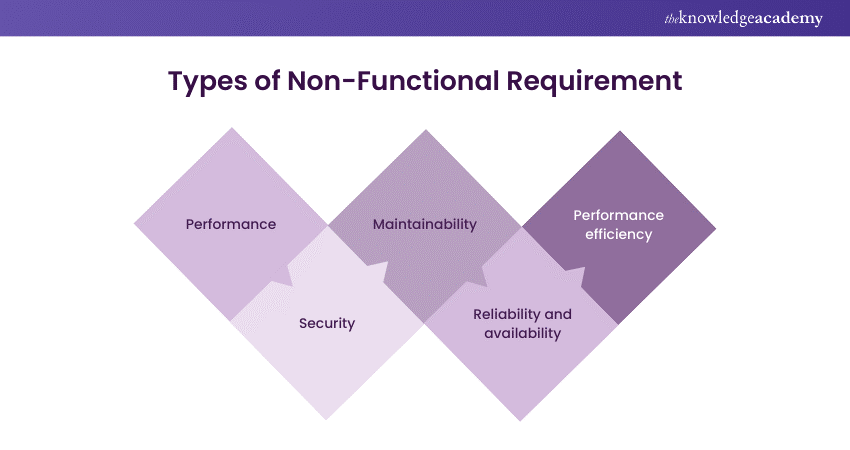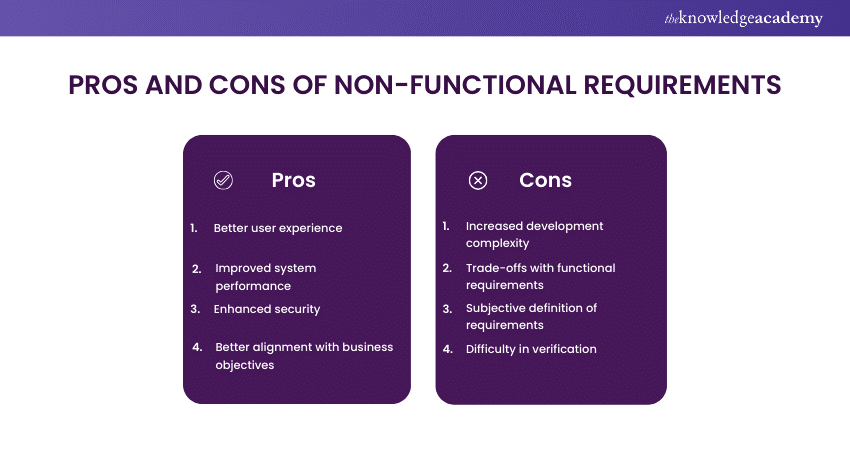We may not have the course you’re looking for. If you enquire or give us a call on +44 1344 203 999 and speak to our training experts, we may still be able to help with your training requirements.
Training Outcomes Within Your Budget!
We ensure quality, budget-alignment, and timely delivery by our expert instructors.

What are Non-Functional Requirements in Software Engineering?” “How do you define these Non-Functional Requirements?” These are crucial questions for anyone involved in the development of robust software systems.
Non Functional Requirements in Software Engineering are the criteria that specify the operation of a system, as opposed to the behaviors or functions. They include aspects like system performance, security, usability, and reliability. Understanding and implementing these requirements is essential for ensuring that the software will perform well under stress, be secure from threats, and remain operational with minimal downtime.
In this blog, we will provide a thorough guide to Non-Functional Requirements in Software Engineering, exploring their importance, types, how to gather and document them, and their impact on the user experience. Let’s delve into the world of Non Functional Requirements in Software Engineering and learn how to integrate them effectively into our software projects.
Table of Contents
1) What is a Non-Functional Requirement?
2) Types of Non-Functional Requirement
3) What constitutes a Non-Functional Requirements document?
4) Pros and Cons of Non-Functional Requirements
5) Guidelines for Crafting Non-Functional Requirements
6) Conclusion
What is a Non-Functional Requirement?
Imagine you're behind the wheel of a sleek sports car, its engine humming powerfully—a testament to what it was built to do: race. However, as you speed along, you notice raindrops seeping in through a leaky roof, a stark reminder that performance isn't just about speed. This scenario perfectly illustrates Non-Functional Requirements (NFRs) in Software Engineering. While the flashy features, like the car's powerful engine capture our attention, the less glamorous but equally vital NFRs, akin to the leaky roof, often determine the overall user experience.
NFRs are those critical behind-the-scenes qualities that dictate how smoothly, securely, and effectively a software system operates. Consider performance: a beautifully designed app that takes forever to load is like a sports car that can't get out of its way. Or security, which is akin to ensuring the car's alarm system is robust enough to protect it from theft. Usability ensures the app feels as natural and intuitive as the car's comfortable and ergonomic seating. Lastly, reliability in software, much like in a car, means that it consistently functions as expected, rain or shine.
By integrating these Non-Functional Requirements thoughtfully throughout the development process, engineers can craft software that delights users with its functionality and ease of use, security, and reliability. So, the next time you find yourself effortlessly navigating a user-friendly app or trusting it with your data, take a moment to appreciate the unseen power and careful consideration of Non-Functional Requirements that make such experiences possible.
Types of Non-Functional Requirement
Here are some of the most common types of Non-Functional Requirements:

1) Performance
Have you ever clicked on a website, only to wait and wait for it to load? It's like being stuck in a traffic jam when you're already late. Performance NFRs are the traffic cops and green lights of the software world, ensuring everything moves quickly and smoothly. They're about setting the gold standards for speed - how swiftly a website responds to your click, how well it can manage a crowd without turning into a digital snarl-up. It's all about making your digital journey as smooth as a highway on a quiet morning.
2) Security
Think of your data as a treasure trove; security NFRs are the sturdy, unbreachable vault protecting it. In a realm where digital pirates lurk around every corner, ready to plunder, these NFRs are the encryption spells and secure portals guarding against unauthorised access and nefarious breaches. They're your digital knights in shining armor, ensuring that prying eyes are kept at bay, and your digital domain remains untouched and safe.
3) Maintainability
Just like a house needs regular upkeep to stay homely, software needs maintenance to stay relevant and functional. Maintainability NFRs are the blueprint for future renovations, ensuring that updates and fixes aren't akin to rebuilding from scratch. With modular design principles acting as easily rearrangeable furniture, clear documentation as the instruction manual, and well-structured code like neatly organised rooms, these NFRs make sure that the software house remains in tip-top shape, welcoming, and easy to navigate for any developer that walks through its doors.
4) Reliability and availability
Picture your trusted online banking portal as a reliable old car that never lets you down—until one day, it does, right when you need it most. Reliability NFRs are the regular tune-ups that prevent such disasters, ensuring your digital ride is smooth and uninterrupted. Availability NFRs are like having a spare car ready; if one fails, another immediately takes its place, guaranteeing that you're never stranded. Together, they ensure that digital services are as dependable as the sunrise, always there when you need them.
5) Performance efficiency
If performance is a sprint, efficiency is a marathon. It's not just about being fast; it's about enduring without wasting precious resources. Performance efficiency NFRs are the wise old sages of software, teaching it to use memory, processing power, and bandwidth judiciously. This wisdom ensures that the software doesn't burn out like a sprinter going too fast but instead paces itself, conserving energy when needed most. This sage advice is invaluable, especially for software running on gadgets where resources are as precious as water in a desert.
Unlock endless career opportunities in the tech industry with our expert led Software Engineering Courses. Sign up now!
What constitutes a Non-Functional Requirements document?
NFR document is a document that tells about the essential qualities required by a software system, apart from its basic functionality. This is like a document representing a way of acting for developers, which the system is to adhere to with reference to performance, security, usability, and other critical features. It contains the following key parts:
a) Introduction: Sets the stage for the document, providing insight into the project's essence and journey. On the other hand, the stakeholder needs to recognise all the expectations of each party so that the software he develops resonates with every person.
b) NFRs outlined: Clearly each of the Non-Functional Requirements outlined so that all aspects of how the software operates meet definite criteria.
c) Prioritisation: Identifies crucial elements requiring immediate attention to prioritise resources effectively.
d) Methods of verification: Outline tests and checks through all stages of development that will ensure the software reaches high standards of functionality and excellence.
Elevate your problem-solving skills to the next level with our comprehensive Systems Modelling Techniques Course. Join today!
Pros and Cons of Non-Functional Requirements
The following are the pros and cons of Non-Functional Requirements.

Pros:
a) Better user experience: These are Non-Functional Requirements that ensure software meets performance, usability, and reliability benchmarks, thus culminating in better holistic user experiences.
b) Improved system performance: This involves specified performance metrics, response time, and throughput, which assist in optimising system performance by the developers, leading to software that is much faster and more efficient during operation.
c) Enhanced security: The Non-Functional Requirements include security features such as encryption standards and access controls that verify sensitive data security while reducing security risks.
d) Better alignment with business objectives: Other Non-Functional Requirements ensure that the software is well aligned with broad business objectives, covering elements including scalability, maintainability, and compliance with standards and regulations applicable in the industry.
Cons:
a) Increased development complexity: Implementation and testing of Non-Functional Requirements may add more complexity to development, translating to extra time and resources during the process.
b) Trade-offs with functional requirements: Sometimes, meeting Non-Functional Requirements calls for compromises in some form of functional requirements.
c) Subjective definition of requirements: Since Non-Functional Requirements like usability and performance are part of the criteria, subjectivity may creep in, making them difficult to define in clear and measurable terms.
d) Difficulty in verification: While functional requirements can be verified through one or more tests, the same cannot be applied to Non-Functional Requirements. This may require specially designed tools and techniques for verification.
Embark on a journey to become a proficient Software Developer with our Software Development Lifecycle Training.
Guidelines for Crafting Non-Functional Requirements
Here are a few geenral guidelines and principles to create Nun Functional Requirements
a) Focus on user needs: Consider what truly matters to the folks using your software. Their needs and dreams should shape the NFRs, ensuring the software feels like it was made just for them.
b) Be specific and measurable: Each NFR should be as clear as a sunny day, with straightforward ways to check if we're hitting the mark. It's like setting a fitness goal—you need to know exactly what success looks like.
c) Prioritise wisely: Not all NFRs are created equal. Figure out which are your project's pillars and give them the spotlight. It's like planning a trip; you can't see everything, so you choose the must-visits.
d) Involve stakeholders: Include everyone in the conversation—users, builders, and maintainers alike. It's like hosting a dinner party; the best nights are when everyone contributes to the feast.
e) Maintain flexibility: The only constant is change, especially in software development. Be ready to tweak and adjust your NFRs as you learn more and the world around your project shifts. It's like jazz—sometimes, you just need to improvise.
Conclusion
In conclusion, integrating Non-Functional Requirements in Software Engineering is pivotal for creating superior software. These requirements ensure that a system is not only functional but also reliable, usable, and secure. Understanding Non-Functional Requirements in Software Engineering is the key to delivering software that excels in quality and performance.
Elevate your engineering expertise with our comprehensive Systems Engineering Training and unlock new opportunities in the dynamic world of technology!
Frequently Asked Questions

Non-Functional Requirements (NFRs) in an SRS document define how the software should perform, not what it should do. They focus on usability, security, performance, and other quality attributes.

Requirements define what a system must do (features), while Non-Functional Requirements specify how it should do it (performance, security, usability).

The Knowledge Academy takes global learning to new heights, offering over 30,000 online courses across 490+ locations in 220 countries. This expansive reach ensures accessibility and convenience for learners worldwide.
Alongside our diverse Online Course Catalogue, encompassing 17 major categories, we go the extra mile by providing a plethora of free educational Online Resources like News updates, Blogs, videos, webinars, and interview questions. Tailoring learning experiences further, professionals can maximise value with customisable Course Bundles of TKA.

The Knowledge Academy’s Knowledge Pass, a prepaid voucher, adds another layer of flexibility, allowing course bookings over a 12-month period. Join us on a journey where education knows no bounds.

The Knowledge Academy offers various Software Engineering Courses, including the Systems Engineering Training and Software Development Lifecycle Training. These courses cater to different skill levels, providing comprehensive insights into Importance of Software Engineering.
Our Programming and DevOps Blogs cover a range of topics related to Non-Functional Requirements, offering valuable resources, best practices, and industry insights. Whether you are a beginner or looking to advance your Software Engineering skills, The Knowledge Academy's diverse courses and informative blogs have got you covered.
Upcoming Programming & DevOps Resources Batches & Dates
Date
 Systems Engineering Training
Systems Engineering Training
Fri 26th Jul 2024
Fri 25th Oct 2024
Wed 5th Mar 3034







 Top Rated Course
Top Rated Course



 If you wish to make any changes to your course, please
If you wish to make any changes to your course, please


